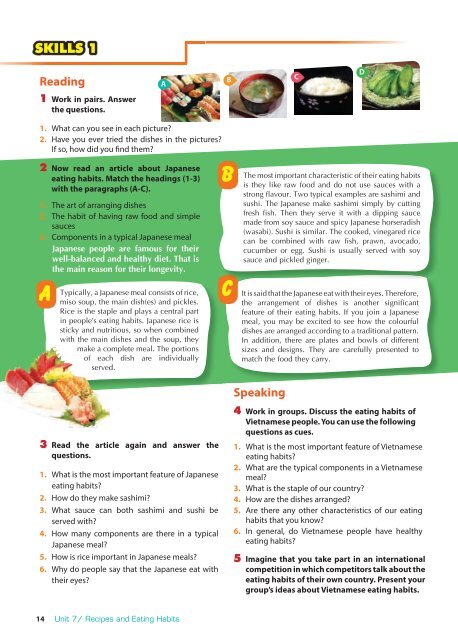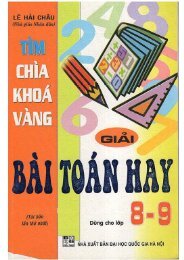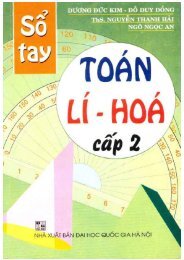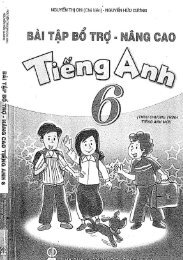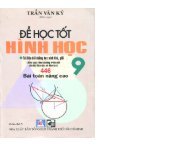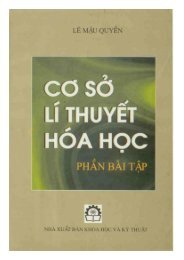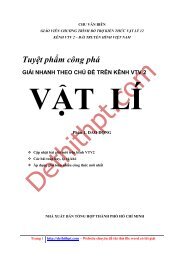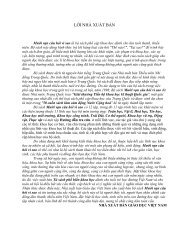Sách giáo viên Tiếng Anh 9 Thí điểm 2 tập (Pilot English 9 for Teacher)
https://app.box.com/s/rnv2yu1duebjhdpkknu2l47p9nmel5ax
https://app.box.com/s/rnv2yu1duebjhdpkknu2l47p9nmel5ax
Create successful ePaper yourself
Turn your PDF publications into a flip-book with our unique Google optimized e-Paper software.
SKILLS 1<br />
Reading<br />
A<br />
B<br />
C<br />
D<br />
1 Work in pairs. Answer<br />
the questions.<br />
1. What can you see in each picture?<br />
2. Have you ever tried the dishes in the pictures?<br />
If so, how did you find them?<br />
2 Now read an article about Japanese<br />
eating habits. Match the headings (1-3)<br />
with the paragraphs (A-C).<br />
1. The art of arranging dishes<br />
2. The habit of having raw food and simple<br />
sauces<br />
3. Components in a typical Japanese meal<br />
Japanese people are famous <strong>for</strong> their<br />
well-balanced and healthy diet. That is<br />
the main reason <strong>for</strong> their longevity.<br />
A<br />
Typically, a Japanese meal consists of rice,<br />
miso soup, the main dish(es) and pickles.<br />
Rice is the staple and plays a central part<br />
in people’s eating habits. Japanese rice is<br />
sticky and nutritious, so when combined<br />
with the main dishes and the soup, they<br />
make a complete meal. The portions<br />
of each dish are individually<br />
served.<br />
B<br />
C<br />
The most important characteristic of their eating habits<br />
is they like raw food and do not use sauces with a<br />
strong flavour. Two typical examples are sashimi and<br />
sushi. The Japanese make sashimi simply by cutting<br />
fresh fish. Then they serve it with a dipping sauce<br />
made from soy sauce and spicy Japanese horseradish<br />
(wasabi). Sushi is similar. The cooked, vinegared rice<br />
can be combined with raw fish, prawn, avocado,<br />
cucumber or egg. Sushi is usually served with soy<br />
sauce and pickled ginger.<br />
It is said that the Japanese eat with their eyes. There<strong>for</strong>e,<br />
the arrangement of dishes is another significant<br />
feature of their eating habits. If you join a Japanese<br />
meal, you may be excited to see how the colourful<br />
dishes are arranged according to a traditional pattern.<br />
In addition, there are plates and bowls of different<br />
sizes and designs. They are carefully presented to<br />
match the food they carry.<br />
Speaking<br />
3 Read the article again and answer the<br />
questions.<br />
1. What is the most important feature of Japanese<br />
eating habits?<br />
2. How do they make sashimi?<br />
3. What sauce can both sashimi and sushi be<br />
served with?<br />
4. How many components are there in a typical<br />
Japanese meal?<br />
5. How is rice important in Japanese meals?<br />
6. Why do people say that the Japanese eat with<br />
their eyes?<br />
4 Work in groups. Discuss the eating habits of<br />
Vietnamese people. You can use the following<br />
questions as cues.<br />
1. What is the most important feature of Vietnamese<br />
eating habits?<br />
2. What are the typical components in a Vietnamese<br />
meal?<br />
3. What is the staple of our country?<br />
4. How are the dishes arranged?<br />
5. Are there any other characteristics of our eating<br />
habits that you know?<br />
6. In general, do Vietnamese people have healthy<br />
eating habits?<br />
5 Imagine that you take part in an international<br />
competition in which competitors talk about the<br />
eating habits of their own country. Present your<br />
group’s ideas about Vietnamese eating habits.<br />
14 Unit 7/ Recipes and Eating Habits


